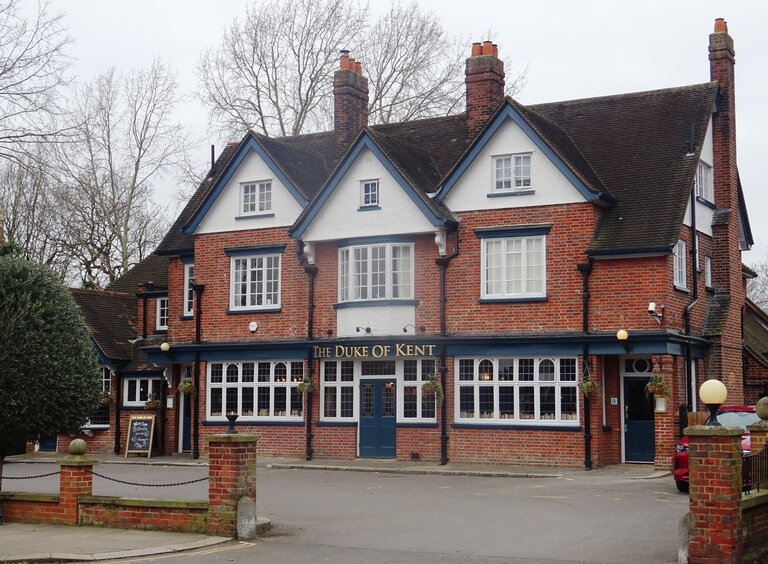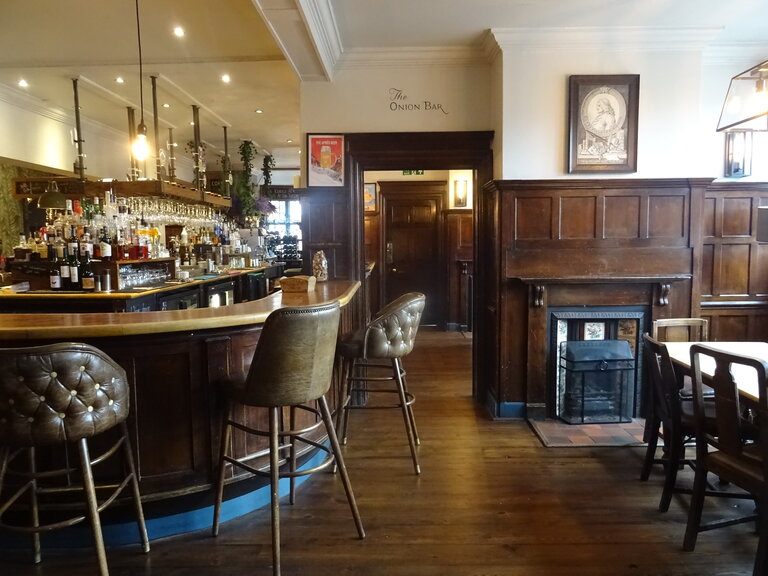Duke of Kent
2 Scotch Common,West Ealing,
W13 8DL
Designed by the architect Thomas Henry Nowell Parr, who was born in Handsworth, West Midlands in 1864. He started his career as an architectural assistant in Walsall Corporation Architects' Department (1890 - 1894) and then moved to Middlesex to work in Brentford Urban District Council (UDC) Architects' Department from 1894 to 1897. From 1897 to 1907 he was Architect, Engineer and Surveyor to Brentford UDC and, while retaining this post, he set up his own architectural practice in 1900. Among his designs for Brentford UDC is Brentford Library, built in 1903 and opened on 9 May 1904 by the American millionaire philanthropist, Andrew Carnegie who had donated £5,000 to the cost of the building. In the same year (1904) a Boatmen's Institute was built for the London City Mission to Nowell Parr's design on the Grand Union Canal at Brentford - it is now a private house. He also undertook commissions from Fuller's and, as mentioned above, the Royal Brewery, Brentford with the Three Horseshoes, Southall and the Forester, West Ealing among his other pubs. Nowell Parr's son, John Nowell Parr (died 1975) joined the architectural practice at some point. In 1914 Thomas Henry Nowell Parr moved from 42 Cranley Gardens, South Kensington to 52 Kew Bridge Road, Brentford. In 1925 he became a Fellow of the Royal Institute of British Architects. He died on 23 September 1933.
This pub is not only a grade II listed building, it is also a One Star pub on the Campaign for Real Ale’s (CAMRA) National Inventory with an interior of special national historic interest, and the description is as follows: “An imposing suburban Fuller’s house rebuilt in 1929 to designs by the excellent pub architect T. H. Nowell Parr and dominated externally by three gables on the rendered frontage. Although the pub has been modernised internally the original arrangements are still very much in evidence, especially along the front. Here there are three distinct rooms with internal partitions, the pair on the right even retaining a doorway between them. Needless to say each of the rooms had its own external entrance. The wall panelling remains as does the bar counter, although the fitting behind seems a fairly modern replacement. In the windows there is some very typical, attractive dimpled glass that was popular with pub-builders around 1930. At the rear the counter is again original. The back parts were extended in 1934 by Hall Jones & Partners to Parr's design. There is a large, hemispherical skylight but there has been extensive opening up and the spaces are now rather confused. However, they offer a pleasant prospect over the large garden at a lower level. On the left-hand side of the pub there seems to have been an off-sales shop which has now been taken into the body of the trading area. History on the spot: The pub is built on the site of Castle Hill Lodge, a 27-acre site with a house (gone by 1840) owned by Edward, Duke of Kent, fourth son of George III and the father of Queen Victoria. The pub was known as the Kent Hotel until 2003.”
The listing description is as follows: “Public House. 1929 by Nowell Parr, extended to rear 1934 by Hall Jones and Partners to Parr's design. Red brick; machine tile roofs. EXTERIOR: south elevation of 2 storeys and dormer attic; 3-window range. Symmetrical main block with projecting central section with 3 attic gables. Recessed doorways to right and left, that to left (west) under moulded flat hood on scrolled consoles leading to saloon bar. Right doorway into public bar within open porch on single brick corner pier. Central half-glazed double doors to private bar flanked by 2-light leaded metal casements either side with stained glass and glazing bars. One 6-light casement of similar design between side doors and central doorway. Continuous timber fascia above windows. First floor with central canted bay window fitted with 4 leaded metal casements, and one 3-light window right and left. Central attic gable projects on scrolled brackets: one single-light casement. Outer gables each with one 2-light casement. 2 stacks on front roof slope. Single-storey gabled west extension with a tripartite bay window with leaded glazing and a half-glazed door to the left, under an overlight. Rear with hipped 2-storey block fitted with 3-light leaded cross casements to first floor and a central ridge stack. Ground floor obscured by single-storey covered terrace added 1934: rebuilt central external staircase to garden rises to 2 double-leaf glazed doors in short extension with glazed doors in returns. Main wall with one 2-light cross casement right and left. Twin-flight external staircases right and left, of 1929, led originally to open terrace. That to west serves part of original terrace. That to east rises to double glazed doors with a 2-light leaded casement to its left. INTERIOR: 3 front bars each with high dado panelling, timber chimneypieces with cast-iron inserts, bench seating, panelled bridging beams and remote winder window openers. 6-panelled doors open from private bar into the others. Curved panelled bar counter serves all three bars. Rear bar in 2 parts. South part is former dining room: panelled bridging beams and small-framed dado panelling. Elaborate carved timber chimneypiece in east wall with carved overmantel mirror and cast-iron fire insert. West wall with 3 six-panelled doors serving cloakrooms and private entrance lobby. North wall broken through in 1934 into north part, the ceiling supported on 3 steel piers. Panelled bridging beams. 2 domed glazed roof lights with glazing bars set in geometric patterns with coloured glass.”
The WhatPub link is here: WhatPub/Duke of Kent
The Pub Heritage Group link is here: PHG/Duke of Kent
The Duke of Kent featured on the Style, Substance and E Numbers: Daytime Crawl of Greenford, West Ealing, Acton and Chiswick on 28 February 2009.





